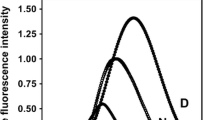Abstract
Effects of hydrostatic pressure on the fluorescence emission of L-tryptophan, N-acetyl-L-trytophanamide and indole were investigated. An increase in pressure ranging from 1 bar to 2.4 kbar results in reversible red-shifts of the emission of the three fluorophores. The pressure-induced redshift amounts to about 170 cm−1 at 2.4 kbar, and appears related to changes in Stokes shift of the fluorophores caused by pressure effects on the dielectric constant and/or refractive index of the medium. As the pressure range investigated here is the range commonly used in studies of protein subunit association and/or folding, these observations raise the need for caution in interpreting pressure-induced spectral shifts. The significance of these observations to pressure studies of proteins is illustrated by investigation of pressure effects on human Cu,Zn Superoxide dismutase (SOD) and azurin fromPseudomonas aeruginosa. A reversible 170 cm−1 red-shift of the emission of SOD was observed upon pressurization to 2.4 kbar. This might be interpreted as pressure-induced conformational changes of the protein. However, further studies using SOD that had been fully unfolded by guanidine hydrochloride, and fluorescence anisotropy measurements indicated that the observed red-shift was likely due to a direct effect of pressure on the fluorescence of the single tryptophan residue of SOD. Similar pressure-induced red-shifts were also observed for the buried tryptophan residue of azurin or for azurin that had been previously denatured by guanidine hydrochloride. These observations further suggest that the effective dielectric constant of the protein matrix is affected by pressure similarly to water.
Similar content being viewed by others
References
G. Weber (1992)Protein Interactions, Chapman and Hall, New York.
J. L. Silva and G. Weber (1993)Annu. Rev. Phys. Chem. 44, 89–113.
M. Gross and R. Jaenicke (1994)Eur. J. Biochem. 221, 617–630.
V. V. Mozhaev, K. Heremans, J. Frank, P. Masson, and C. Balny (1994)Trends Biotechnol. 12, 493–501.
G. Weber and H. G. Drickamer (1983)Q. Rev. Biophys. 16, 89–112.
M. R. Eftink, C. A. Ghiron, R. A. Kautz, and R. O. Fox (1991)Biochemistry 30, 1193–1199.
C. A. Royer, A. P. Hinck, S. N. Loh, K. E. Prehoda, X. Peng, J. Jonas, and J. L. Markley (1993)Biochemistry 32, 5222–5232.
G. J. A. Vidugiris, J. L. Markley, and C. A. Royer (1995)Biochemistry 34, 4909–4912.
D. Foguel and J. L. Silva (1994)Proc. Natl. Acad. Sci. USA 91, 8244–8247.
D. Foguel and G. Weber (1995)J. Biol. Chem. 270, 8244–8247.
J. R. Lakowicz (1983)Principles of Fluorescence Spectroscopy, Plenum Press, New York.
J. V. Bannister and W. H. Bannister (1984)Methods Enzymol. 105, 88–93.
A. A. Paladini and G. Weber (1981)Biochemistry 20, 2587–2593.
G. Mei, N. Rosato, N. Silva, Jr., R. Rusch, E. Gratton, I. Savini, and A. Finazzi-Agro (1992)Biochemistry 31, 7224–7230.
H. E. Parge, R. A. Hallewell, and J. A. Tainer (1992)Proc. Natl. Acad. Sci. USA 89, 6109–6113.
N. J. Silva (1993) PhD Thesis, University of Illinois at UrbanaChampaign.
P. Cioni and G. B. Strambini (1994)J. Mol. Biol. 242, 291–301.
T. M. Li, J. W. Hook, III, H. G. Drickamer, and G. Weber (1976)Biochemistry 15, 3205–3211.
T. M. Li, J. W. Hook, III, H. G. Drickamer, and G. Weber (1976)Biochemistry 15, 5571–5580.
T. Coelho-Sampaio, S. T. Ferreira, G. Benaim, and A. Vieyra (1991)J. Biol. Chem. 266, 22266–22272.
N. Malaga, Y. Kaifu, and M. Koizumi (1956)Bull. Chem. Soc. Jpn. 29, 465–470.
E. Lippert (1957)Z. Electrochem. 61, 962–975.
N. G. Bakhshiev (1961)Opt. Spectrosc. 10, 379–384.
N. G. Bakhshiev (1962)Opt. Spectrosc. 12, 309–313.
N. G. Bakhshiev (1962)Opt. Spectrosc. 13, 24–29.
A. Kawski (1966)Acta Phys. Pol. 29, 507–518.
S. Kyropoulos (1926)Z. Phys. Chem. 40, 507.
P. W. Bridgman (1931)The Physics of High Pressure, G. Bell and Sons, London.
M. Sun, and P.-S. Song (1977)Photochem. Photobiol. 25, 3–9.
G. S. Chryssomallis, P. M. Torgerson, H. G. Drickamer, and G. Weber (1981)Biochemistry 20, 3955–3959.
T. G. Politis, and H. G. Drickamer (1981)J. Chem. Phys. 75, 3203–3210.
Author information
Authors and Affiliations
Rights and permissions
About this article
Cite this article
Louzada, P.R.F., Scaramello, M.E., Maya-Monteiro, C. et al. Effect of hydrostatic pressure on the fluorescence of indole derivatives. J Fluoresc 6, 231–236 (1996). https://doi.org/10.1007/BF00732826
Received:
Accepted:
Issue Date:
DOI: https://doi.org/10.1007/BF00732826




